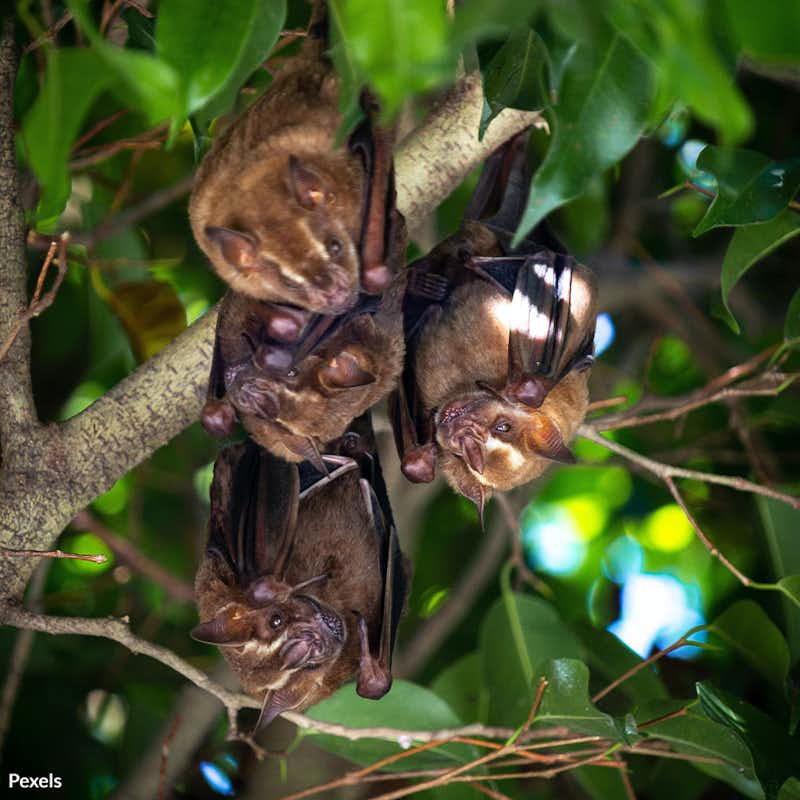Save Our Ecological Superheroes from Looming Extinction
14,280 signatures toward our 30,000 Goal
Sponsor: The Animal Rescue Site
From pest control to pollination, bats are true superheroes. But many bat species are facing extinction. Take action for bats!

Bats, those remarkable and often under-appreciated creatures, play a vital role in maintaining the delicate balance of our natural world. North America boasts a rich diversity of bat species, each with its own unique characteristics and ecological niche1. From the insect-devouring Little Brown Bat to the nectar-feeding Mexican Long-nosed Bat, these fascinating creatures have thrived across diverse ecosystems, showcasing their adaptability and significance.
Bats are true ecological superheroes. They provide invaluable pest control services by consuming vast quantities of insects that damage crops and spread diseases. In just one hour, a single bat can devour hundreds of insects, making them a natural and efficient form of pest management2. Moreover, certain bat species have evolved specialized relationships with plants, acting as crucial pollinators3. For example, the Mexican Long-nosed Bat plays a vital role in pollinating agave plants, while the Hawaiian Hoary Bat disperses seeds and maintains plant diversity3.
Sadly, numerous bat species in the United States are currently experiencing alarming declines, primarily due to the devastating White-Nose Syndrome (WNS)4. The once-abundant Little Brown Bat5 has suffered catastrophic losses, with some populations declining over 90%. Federally endangered species like the Indiana Bat6 and the Gray Bat7 are also facing significant declines. The Mexican Long-nosed Bat8, crucial for pollinating agave plants, and other species such as the Townsend's Big-eared Bat9 and the Hawaiian Hoary Bat10, are also at risk.
These declining populations result from a combination of threats. Habitat loss, climate change, pesticides, wind energy development, and disturbance of roosting sites pose significant challenges to bats and their survival11. Deforestation and urbanization reduce available roosting areas12, while pesticides harm bat populations by reducing their prey base and directly affecting their health13. The rapid expansion of wind energy facilities further endangers bats through collisions and barotrauma14.
The extinction of bat species would have far-reaching consequences for North America's ecosystems and human societies. Without bats, insect populations would surge, leading to increased crop damage, reduced agricultural yields, and potential threats to human health15. The delicate balance of plant-pollinator relationships would be disrupted, impacting plant reproduction and biodiversity16. Furthermore, bats hold cultural significance and have inspired art, literature, and scientific research throughout history17. Losing bats would not only deplete biological diversity but also erode cultural heritage and ecological integrity.
Recent developments pose a threat to the protection of bats and other endangered species. The U.S. Senate passed Congressional Review Act (CRA) resolutions aimed at overturning crucial regulations related to the Endangered Species Act (ESA)18. These actions have significant implications for the conservation of bats in North America. The resolutions rescinded critical habitat definitions and federal protections for the northern long-eared bat, and conservation groups have expressed deep concern about the politicization of this vital law.
We cannot stand idly by as our bat species face imminent peril. Immediate action is needed to protect and conserve threatened bats in North America. One crucial step is to extend the protections of the ESA to these species, ensuring legal safeguards and conservation measures to prevent their extinction and preserve their habitats.
Sign the petition today and add your voice to the growing movement to extend the protections of the Endangered Species Act (ESA) to threatened bat species. Together, we can compel Federal action and ensure the survival of these invaluable members of our ecosystems.
- Bat Conservation Internatonal (2023), "Bat Profiles."
- Nexus Newsfeed (17 November 2018), "Why bats are ecological superheroes."
- Animalia (2023), "Greater Long-Nosed Bat."
- Lauren Leffer, National Geographic (16 July 2021), "White-nose syndrome has devastated bats—but some are developing immunity."
- Elizabeth Claire Alberts, Mongabay (14 May 2020), "Endangered bats are evolving to fight off an exotic fungal disease."
- Humane Indiana, "The Indiana Bat."
- EnviroScience, "Endangered Bat Surveys."
- Bat Conservation International (2023), "Long-Nosed Bats and Agaves: The Tequila Connection."
- Bat Conservation International (2023), "Species Spotlight: Townsends Big-Eared Bat."
- Bat Conservation International (2023), "Hawaiian Hoary Bat."
- Winifred F. Frick, Tigga Kingston, Jon Flanders, Annals Of The New York Academy Of Sciences (2019), "A review of the major threats and challenges to global."
- Manfredo A. Turcios-Casco, Richard K. LaVal, Marcio Martínez, Hefer D. Ávila-Palma, Natural History and Ecology of Mexico and Central America (8 February 2021), "More Urbanization, Fewer Bats: The Importance of Forest Conservation in Honduras."
- Universität Koblenz-Landau (27 August 2021), "Pesticides endanger bats."
- Dr. Paul Cryan, United States Geological Survey (26 February 2008), "Overview of Issues Related to Bats and Wind Energy."
- The Bat Conservation Trust, "Insect control."
- The Bat Conservation Trust, "Bats as Indicators of Biodiversity."
- Bat Conservation International (2023), "Folklore and the Origin Of Bats."
- Zack Budryk, The Hill (11 May 2023), "Senate passes two resolutions overturning Biden endangered species protections."
The Petition:
To the Secretary of the Interior, House Natural Resources Committee and the Senate Committee on Energy and Natural Resources,
I am writing to you as a concerned citizen of the United States to express my deep concern for the well-being and conservation of threatened bat species in our country. Specifically, I urge you to take immediate action to extend the protections of the Endangered Species Act (ESA) to the northern long-eared bat (Myotis septentrionalis) and other at-risk bat species.
Bats are not only fascinating creatures but also integral to the health and balance of our ecosystems. They serve as critical pollinators, natural pest controllers, and contributors to the biodiversity of our environment. However, these extraordinary animals are facing alarming declines in their populations due to various factors, including habitat loss, climate change, pesticides, and the devastating impacts of White-Nose Syndrome (WNS).
The northern long-eared bat, in particular, is highly susceptible to WNS, a disease causing significant mortality in hibernating bats. This species has experienced drastic declines across its range and is currently listed as threatened under the ESA. However, the recent decision to overturn federal protections for the northern long-eared bat puts its survival at even greater risk.
I firmly believe that the ESA provides essential legal safeguards and conservation measures necessary to prevent the extinction of endangered and threatened species and their habitats. By extending ESA protections to the northern long-eared bat and other threatened bat species, we can enhance their chances of recovery and ensure the preservation of these unique and vital components of our natural heritage.
I urge you to support the inclusion of threatened bat species under the protection of the ESA by taking the following actions:
- Sponsor or co-sponsor legislation that extends ESA protections to threatened bat species, including the northern long-eared bat, as a proactive measure to prevent further population declines and ensure their recovery.
- Advocate for increased funding for bat research, habitat preservation, and disease management initiatives. These resources are crucial for understanding the threats facing bats, developing effective conservation strategies, and promoting public awareness and education.
- Collaborate with relevant government agencies, conservation organizations, and scientific experts to prioritize the conservation and recovery of threatened bat species. By fostering partnerships and engaging in cooperative efforts, we can maximize the impact of conservation actions and promote long-term sustainability.
- Recognize and address the cumulative threats faced by bats, including habitat loss, climate change, pesticides, wind energy development, and disturbance of roosting sites. Implement policies and regulations that mitigate these threats and ensure the protection of critical bat habitats across their range.
I believe that by taking immediate and decisive action, we can safeguard the future of threatened bat species and secure the ecological integrity of our nation's ecosystems. It is our responsibility to be stewards of our natural world, ensuring its preservation for future generations.
I respectfully request your support and commitment to the conservation of threatened bat species by advocating for the extension of ESA protections. Together, we can make a difference and ensure a brighter future for these remarkable creatures.
Thank you for your attention to this urgent matter. I look forward to your strong leadership and dedication to the preservation of our endangered and threatened bat species.
Sincerely,
 Welcome Back! Log In to Continue
Welcome Back! Log In to Continue